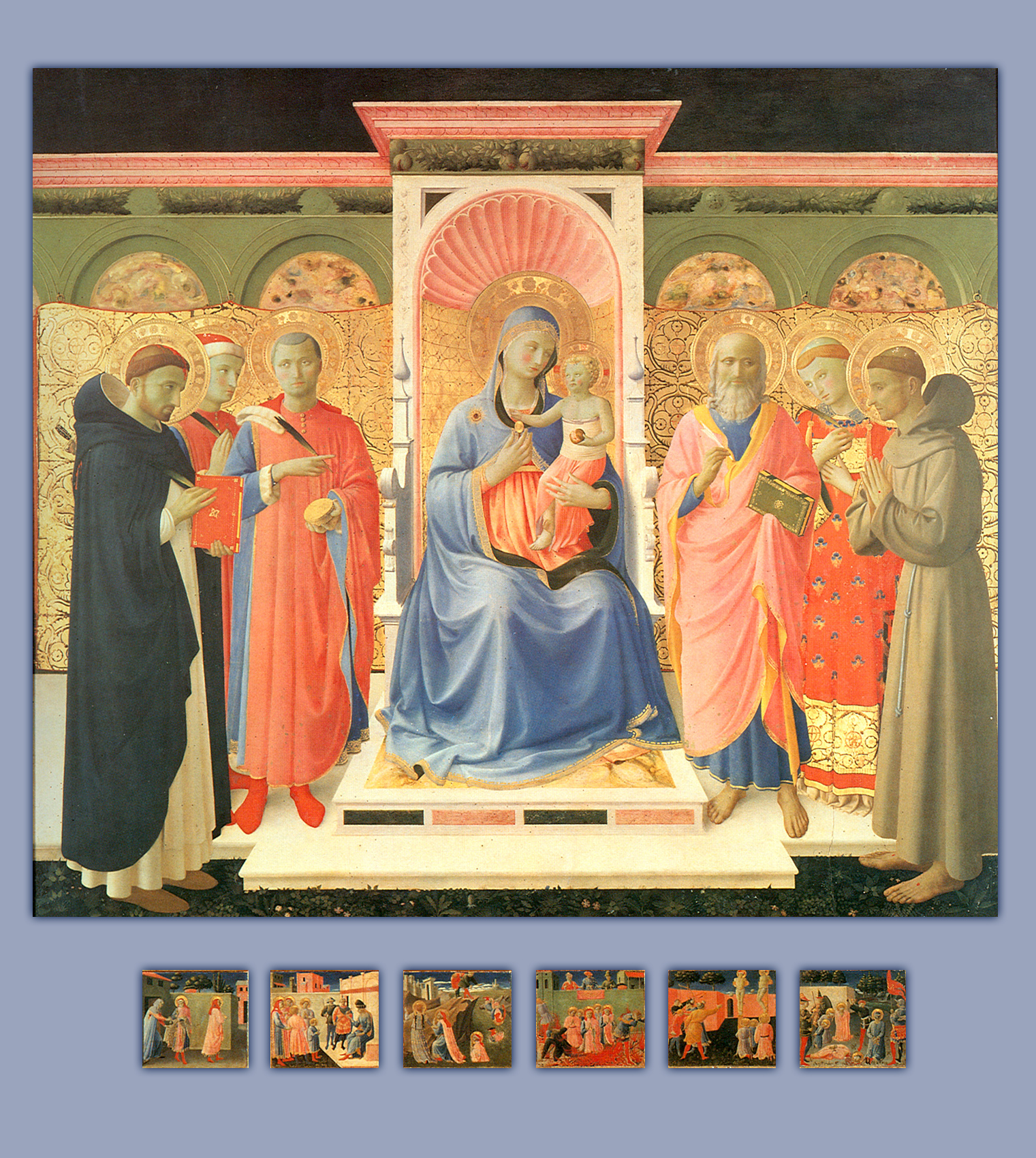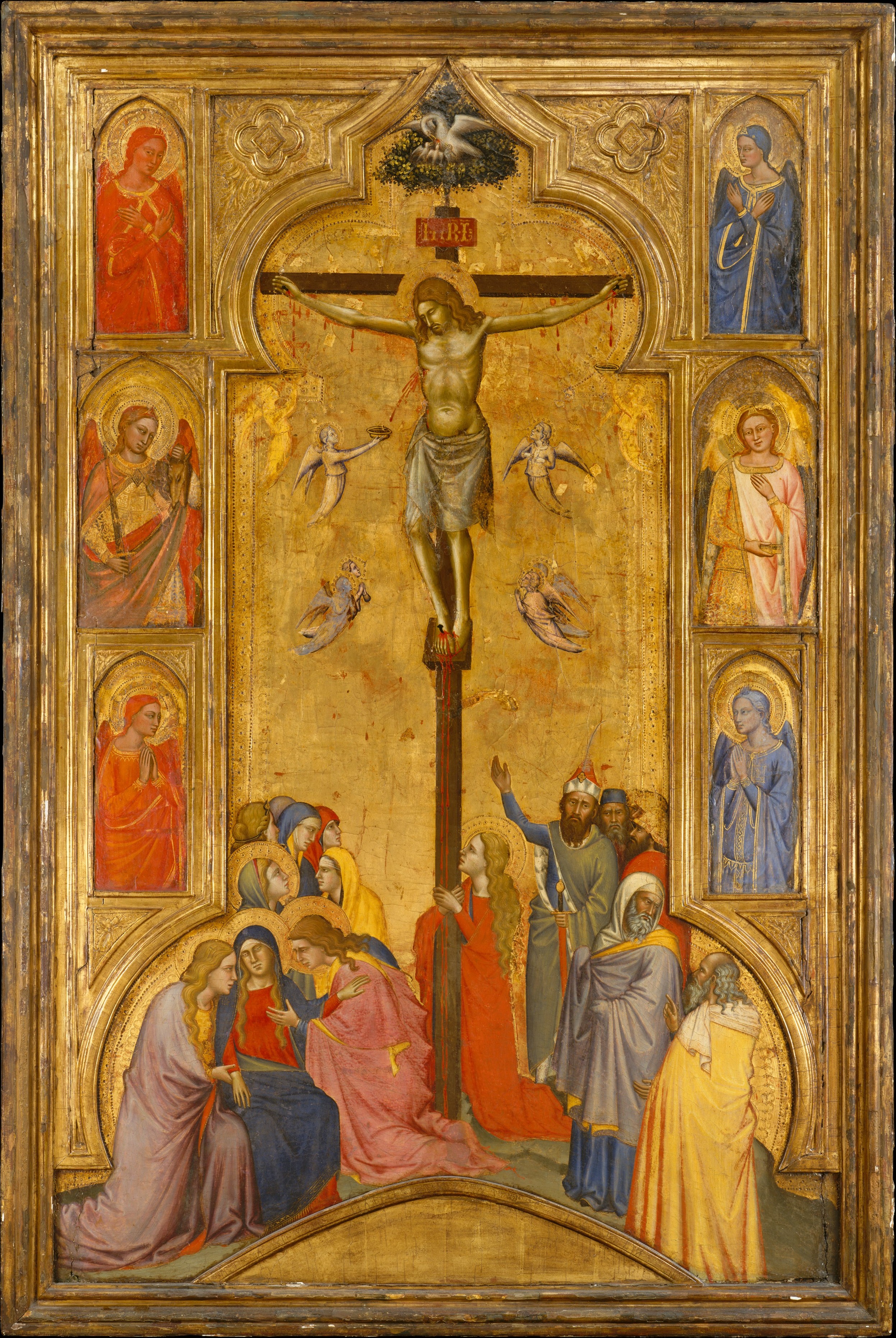|
San Marco Altarpiece
The ''San Marco Altarpiece'' (also known as ''Madonna and Saints'') is a painting by the Italian early Renaissance painter Fra Angelico, housed in the San Marco Museum of Florence, Italy. It was commissioned by Cosimo de' Medici the Elder, and was completed sometime between 1438 and 1443. In addition to the main panel depicting the enthroned Virgin and Child surrounded by Angels and Saints, there were nine predella panels accompanying it, narrating the legend of the patron saints, Saints Cosmas and Damian. Only the main panel actually remains to be seen in the Convent of San Marco, Florence, Italy, today, along with two predella panels depicting saints which were purchased back for the museum as recently as 2007. The ''San Marco Altarpiece'' is known as one of the best early Renaissance paintings for its employment of metaphor and perspective, ''trompe-l'œil'', and the intertwining of Dominican religious themes and symbols with contemporary, political messages. Backg ... [...More Info...] [...Related Items...] OR: [Wikipedia] [Google] [Baidu] |
Fra Angelico
Fra Angelico (born Guido di Pietro; February 18, 1455) was an Italian painter of the Early Renaissance, described by Vasari in his '' Lives of the Artists'' as having "a rare and perfect talent".Giorgio Vasari, ''Lives of the Artists''. Penguin Classics, 1965. He earned his reputation primarily for the series of frescoes he made for his own friary, San Marco, in Florence. He was known to contemporaries as Fra Giovanni da Fiesole (Brother John of Fiesole) and Fra Giovanni Angelico (Angelic Brother John). In modern Italian he is called ''Beato Angelico'' (Blessed Angelic One); the common English name Fra Angelico means the "Angelic friar". In 1982, Pope John Paul II proclaimed him "blessed" in recognition of the holiness of his life, thereby making the title of "Blessed" official. Fiesole is sometimes misinterpreted as being part of his formal name, but it was merely the name of the town where he took his vows as a Dominican friar, and was used by contemporaries to distingu ... [...More Info...] [...Related Items...] OR: [Wikipedia] [Google] [Baidu] |
Sacra Conversazione
In art, a (; plural: ''sacre conversazioni''), meaning holy (or sacred) conversation, is a genre developed in Italian Renaissance painting, with a depiction of the Virgin and Child (the Virgin Mary with the infant Jesus) amidst a group of saints in a relatively informal grouping, as opposed to the more rigid and hierarchical compositions of earlier periods. Donor portraits may also be included, generally kneeling, often their patron saint is presenting them to the Virgin, and angels are frequently in attendance. The term is often used as a title for paintings to avoid listing all the individual figures, although the trend in museums and academic art history is now to give the full list. The name, which only appears as a title retrospectively in the 18th century, has been explained with reference to "their rapt stillness of mood, in which the Saints, scarcely looking at one another, seem to communicate at a spiritual rather than a material level". At least that is the case in ea ... [...More Info...] [...Related Items...] OR: [Wikipedia] [Google] [Baidu] |
Council Of Florence
The Council of Florence is the seventeenth ecumenical council recognized by the Catholic Church, held between 1431 and 1449. It was convoked as the Council of Basel by Pope Martin V shortly before his death in February 1431 and took place in the context of the Hussite Wars in Bohemia and the rise of the Ottoman Empire. At stake was the greater conflict between the conciliar movement and the principle of papal supremacy. The Council entered a second phase after Emperor Sigismund's death in 1437. Pope Eugene IV convoked a rival Council of Ferrara on 8 January 1438 and succeeded in drawing some of the Byzantine ambassadors who were in attendance at Basel to Italy. The remaining members of the Council of Basel first suspended him, declared him a heretic, and then in November 1439 elected an antipope, Felix V. After becoming the Council of Florence (having moved to avoid the plague in Ferrara), the Council concluded in 1445 after negotiating unions with the various eastern ch ... [...More Info...] [...Related Items...] OR: [Wikipedia] [Google] [Baidu] |
Cypress
Cypress is a common name for various coniferous trees or shrubs of northern temperate regions that belong to the family Cupressaceae. The word ''cypress'' is derived from Old French ''cipres'', which was imported from Latin ''cypressus'', the latinisation of the Greek κυπάρισσος (''kyparissos''). Cypress trees are a large classification of conifers, encompassing the trees and shrubs from the cypress family (Cupressaceae) and many others with the word “cypress” in their common name. Many cypress trees have needle-like, evergreen foliage and acorn-like seed cones. Species Species that are commonly known as cypresses include: Most prominently: *Cypress (multiple species within the genus '' Cupressus'') Otherwise: *African cypress (''Widdringtonia'' species), native to Southern Africa *Bald, Pond, and Montezuma cypresses (''Taxodium'' species), native to North America *Chinese swamp cypress (''Glyptostrobus pensilis''), Vietnam, critically endangered *Cordilleran ... [...More Info...] [...Related Items...] OR: [Wikipedia] [Google] [Baidu] |
Wisdom Of Sirach
The Book of Sirach () or Ecclesiasticus (; abbreviated Ecclus.) is a Jewish work, originally in Hebrew, of ethical teachings, from approximately 200 to 175 BC, written by the Judahite scribe Ben Sira of Jerusalem, on the inspiration of his father Joshua son of Sirach, sometimes called Jesus son of Sirach or Yeshua ben Eliezer ben Sira. In Egypt, it was translated into Greek by the author's unnamed grandson, who added a prologue. This prologue is generally considered the earliest witness to a canon of the books of the prophets, and thus the date of the text is the subject of intense scrutiny. The book itself is the largest wisdom book from antiquity to have survived. Canonical status Sirach is accepted as part of the canon by Catholics, Eastern Orthodox, and most Oriental Orthodox Christians. The Anglican tradition considers Sirach (which was published with other Greek Jewish books in a separate section of the King James Bible) among the apocryphal books, and read them "f ... [...More Info...] [...Related Items...] OR: [Wikipedia] [Google] [Baidu] |
Mark's Gospel
The Gospel of Mark), or simply Mark (which is also its most common form of abbreviation). is the second of the four canonical gospels and of the three synoptic Gospels. It tells of the ministry of Jesus from his baptism by John the Baptist to his death, burial, and the discovery of his empty tomb. There is no miraculous birth or doctrine of divine pre-existence, nor, in the original ending ( Mark 16:1–8), any post-resurrection appearances of Jesus. It portrays Jesus as a teacher, an exorcist, a healer, and a miracle worker. He refers to himself as the Son of Man. He is called the Son of God, but keeps his messianic nature secret; even his disciples fail to understand him. All this is in keeping with Christian interpretation of prophecy, which is believed to foretell the fate of the messiah as suffering servant. The gospel ends, in its original version, with the discovery of the empty tomb, a promise to meet again in Galilee, and an unheeded instruction to spread the good ... [...More Info...] [...Related Items...] OR: [Wikipedia] [Google] [Baidu] |
Eucharistic
The Eucharist (; from Greek , , ), also known as Holy Communion and the Lord's Supper, is a Christian rite that is considered a sacrament in most churches, and as an ordinance in others. According to the New Testament, the rite was instituted by Jesus Christ during the Last Supper; giving his disciples bread and wine during a Passover meal, he commanded them to "do this in memory of me" while referring to the bread as "my body" and the cup of wine as "the blood of my covenant, which is poured out for many". The elements of the Eucharist, sacramental bread (leavened or unleavened) and wine (or non-alcoholic grape juice), are consecrated on an altar or a communion table and consumed thereafter, usually on Sundays. Communicants, those who consume the elements, may speak of "receiving the Eucharist" as well as "celebrating the Eucharist". Christians generally recognize a special presence of Christ in this rite, though they differ about exactly how, where, and when Christ is prese ... [...More Info...] [...Related Items...] OR: [Wikipedia] [Google] [Baidu] |
Gold Background
Gold ground (both a noun and adjective) or gold-ground (adjective) is a term in art history for a style of images with all or most of the background in a solid gold colour. Historically, real gold leaf has normally been used, giving a luxurious appearance. The style has been used in several periods and places, but is especially associated with Byzantine and medieval art in mosaic, illuminated manuscripts and panel paintings, where it was for many centuries the dominant style for some types of images, such as icons. For three-dimensional objects, the term is gilded or gold-plated. Gold in mosaic began in Roman mosaics around the 1st century AD, and originally was used for details and had no particular religious connotation, but in Early Christian art it came to be regarded as very suitable for representing Christian religious figures, highlighting them against a plain but glistering background that might be read as representing heaven, or a less specific spiritual plane. Fu ... [...More Info...] [...Related Items...] OR: [Wikipedia] [Google] [Baidu] |
Francis Of Assisi
Giovanni di Pietro di Bernardone, better known as Saint Francis of Assisi ( it, Francesco d'Assisi; – 3 October 1226), was a mystic Italian Catholic friar, founder of the Franciscans, and one of the most venerated figures in Christianity. He was inspired to lead a life of poverty and itinerant preaching. Pope Gregory IX canonized him on 16 July 1228. He is usually depicted in a robe with a rope as belt. In 1219, he went to Egypt in an attempt to convert the sultan al-Kamil and put an end to the conflict of the Fifth Crusade. In 1223, he arranged for the first Christmas live nativity scene. According to Christian tradition, in 1224 he received the stigmata during the apparition of a Seraphic angel in a religious ecstasy. He founded the men's Order of Friars Minor, the women's Order of St. Clare, the Third Order of St. Francis and the Custody of the Holy Land. Once his community was authorized by the Pope, he withdrew increasingly from external affairs. Francis ... [...More Info...] [...Related Items...] OR: [Wikipedia] [Google] [Baidu] |
Peter Of Verona
Peter of Verona (1205 – April 6, 1252), also known as Saint Peter Martyr and Saint Peter of Verona, was a 13th-century Italian Catholic priest. He was a Dominican friar and a celebrated preacher. He served as Inquisitor in Lombardy, was killed by an assassin, and was canonized as a Catholic saint 11 months after his death, making this the fastest canonization in history. Biography Thomas Agni of Leontino, Dominican archbishop of Cosenza, and later patriarch of Jerusalem, was the first to write a biography of Peter of Verona. He lived for many years with Peter of Verona and had been his superior. Peter was born in the city of Verona into a family perhaps sympathetic to the Cathar heresy. Peter went to a Catholic school, and later to the University of Bologna, where he is said to have maintained his orthodoxy and, at the age of fifteen, met Dominic of Osma. Peter joined the Order of the Friars Preachers (Dominicans) and became a celebrated preacher throughout northern and centr ... [...More Info...] [...Related Items...] OR: [Wikipedia] [Google] [Baidu] |

.jpg)

.jpg)





